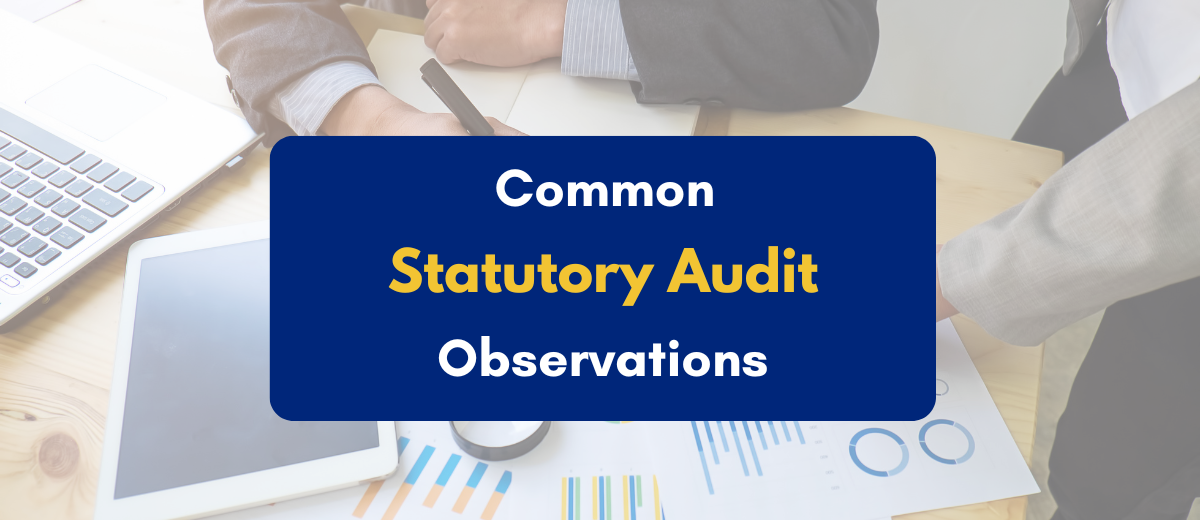Understanding the most common statutory audit observations beforehand is a must if you wish to avoid penalties, reputational damage, and operational risks.
Learn with us the most common statutory audit observations in India and tips on how to avoid these.
What Are Statutory Audit Observations & Why Are They Important?
Statutory audit observations are formal, written comments made by an independent auditor during a company’s statutory audit.
They are included within their audit report or management letter. They highlight areas where:
- Accounting records or financial statements don’t fully comply with accounting standards or relevant laws.
- Internal controls have weaknesses that could lead to errors or fraud.
- Company policies or procedures weren’t properly followed.
- Significant risks or uncertainties exist that need disclosure.
- Instances of non-compliance with laws or regulations were found.
Role of Statutory Audit Observations
- Ensuring Compliance & Avoiding Penalties: Highlight gaps in compliance with tax laws, company law, and industry regulations. Addressing them early helps avoid fines, legal issues, and reputational harm.
- Strengthening Financial Integrity: Identify errors or misstatements in financial reports. Correcting these ensures accuracy, enabling better decisions by management, investors, and the board.
- Improving Internal Controls: Reveal weaknesses in controls over reporting, asset protection, or fraud prevention. Strengthening these reduces risk and supports sound governance.
- Enhancing Operational Efficiency: Uncover inefficient processes or unclear procedures. Fixing them leads to cost savings, smoother operations, and better resource use.
- Boosting Stakeholder Confidence: By acting on audit observations, companies show accountability—building trust with investors, lenders, regulators, and the board.
- Providing Early Warning Signals: Flag early signs of larger financial, operational, or compliance issues. Timely action helps prevent small problems from becoming major risks.

Most Common Statutory Audit Observations in India
Statutory audits in India frequently uncover some issues that are mostly driven by the complexities of regulations, operational challenges, and evolving compliance requirements.
Some of the most common observations we have experienced at PKC’s statutory audits include:
1. Financial Statement and Accounting Issues
Observations directly impacting accuracy of financial reporting
- Revenue Recognition Errors: Timing mismatches, cut-off issues, and incorrect application of revenue standards, especially around performance obligations or variable consideration.
- Misclassification of Expenses: Capital items booked as revenue expenses or vice versa; omissions in accruals or prepayments leading to period mismatches.
- Fixed Asset and Depreciation Gaps: Incomplete asset registers, incorrect depreciation rates or useful life, and failure to record impairment losses as per accounting norms.
- Inventory Valuation Issues: Not valuing inventory at the lower of cost or net realizable value, and lack of provisions for obsolete or slow-moving stock.
- Disclosure Deficiencies: Missing or insufficient details in Notes to Accounts, especially regarding related party transactions.
- Poor Provisioning for Expenses/Liabilities: Insufficient provisions for doubtful debts, employee benefits, warranties, or restructuring costs.
2. Compliance with Companies Act, 2013
Statutory and governance-related shortcomings
- CARO 2020 Non-Compliance: Gaps in reporting on key matters such as asset records, internal audits, fraud instances, or CSR obligations.
- Related Party Transactions: Lack of proper approvals from audit committees, boards, or shareholders; inadequate disclosures in financials.
- Director Remuneration Issues: Payments made beyond prescribed limits or without required approvals.
- Governance Failures: Non-compliance in board composition, frequency of meetings, or formation of mandatory committees.
- Improper Maintenance of Books of Accounts: Incomplete/incorrect primary accounting records.
- Non-Maintenance of Statutory Registers: Registers of members, directors, contracts, etc., not updated or missing.
- Missing/Incomplete Board Meeting Minutes: Inadequate documentation of meetings or resolutions.
3. Internal Controls and Risk Management
Operational control weaknesses that increase exposure to errors or fraud
- Segregation of Duties Failures: Concentration of critical roles like authorization, custody, and recording with a single individual.
- Reconciliation Delays: Unreconciled or late reconciliations of banks, vendors, or customers, often left unreviewed.
- Approval Lapses: High-value transactions executed without appropriate authorizations.
- IT Control Weaknesses: Inadequate access controls, missing data backups, and poor cybersecurity practices affecting financial systems.
- Unreconciled Bank Accounts: Outstanding entries not cleared, unreviewed differences.
- Physical Verification Not Done: For inventory/fixed assets.
4. Tax Compliance Issues
Common lapses in indirect and direct tax compliance
- GST Gaps: Mismatch in input tax credit claims versus supplier filings, incorrect tax rates, or delayed return submissions.
- TDS and TCS Defaults: Errors in deduction or deposit, late payments, incorrect PAN details, and inaccurate filing of returns.
- Income Tax Irregularities: Unrecorded liabilities, misclassification of disallowable expenses, and mismatch in advance tax payments.
5. Loan and Borrowing Related Observations
Risk areas in debt-related disclosures and accounting
- Covenant Violations: Breaches in financial covenants such as leverage ratios or DSCR, often undisclosed or inadequately provided for.
- Borrowing Cost Errors: Failure to capitalize interest on qualifying assets where required.
- Unrecorded Loan Obligations: Omission of loans or interest payable in books.
- Security Documentation Gaps: Incomplete filings related to creation or modification of charges.
6. Provisions and Contingencies
Issues in recognizing and reporting liabilities
- Under-Provisioning: Failure to account for obligations like warranties or restructuring costs, despite meeting recognition criteria.
- Disclosure Omissions: Pending litigations, guarantees, or financial commitments not reported in the financials.
- Over-Provisioning: Inflated or unsupported provisions without a reasonable basis.
7. Documentation and Evidence
Deficiencies in record-keeping and transaction tracing
- Missing Records: Lack of supporting documents such as invoices, approvals, or contracts for significant transactions.
- Weak Audit Trail: Inability to trace transactions from source to financial reporting.
- Verification Shortfalls: Unsigned or missing reports for physical verification of inventory or fixed assets, with unresolved differences.
Sector-Wise Statutory Audit Observations
Statutory audit observations vary widely with each industry as every sector in India faces its own unique compliance risks.
Here’s a tabulated look at some key sector-wise statutory audit observations:
| Industry | Top Statutory Audit Observations |
| Manufacturing | Inventory not physically verifiedWrong classification of capital vs revenue expensesInaccurate valuation of closing stockGST input credit mismatchUnrecorded asset impairments for idle machinery |
| Retail | GSTR-2B vs books mismatchReturns and refunds not properly recordedMissing supporting invoices for discountsCash handling irregularitiesMissing GRNs for vendor stock receipts |
| IT/ITES | Revenue recognized without deliverablesDeferred revenue not accountedSoftware development cost not capitalizedPayroll compliance (ESI/PF) issuesESOP accounting non-compliance |
| Bank/NBFC | Incorrect NPA classificationShortfall in provisioning for bad loansNon-compliance with KYC normsKYC/AML documentation gapsInadequate loan loss provisioning (IRAC non-compliance) |
| Healthcare & Pharma | Free samples not accounted as expenseExpired stock not written offR&D costs wrongly treatedCash payments to doctors (violation risk) Expiry-date inventory provisioning gaps |
| Real Estate & Construction | Revenue booked without project completionNon-capitalization of borrowing costsDelay in project approvals not disclosedGST not reconciled with RERA filingsIncorrect WIP capitalization |
| Educational Institutions | Capitation fee not reportedReceipts without donor PANFaculty paid in cashGrants/utilization not matchedNon-compliant related-party transactions with affiliated trusts |
What Makes PKC Best Option for Statutory Audits/ Preparation?
✅35+ years proven expertise in statutory auditing
✅Pre-audit health checks to eliminate common observations
✅Automated compliance calendars – never miss deadlines
✅Rigorous internal control testing frameworks
✅Zero surprise qualifications – transparent risk alerts
✅Cost-reduction focus via efficient audit workflows
✅Prevention-first approach slashes observations
✅Beyond compliance – identifying growth opportunities
✅Multi-industry specialization across all business sectors
✅Penalty avoidance through thorough regulatory adherence
✅Cleaner audits, fewer penalties, stress-free compliance.
How to Avoid Common Statutory Audit Observations: Top Tips
Most statutory audit issues can be avoided. Here are some tips to help you stay on track:
- Maintain Books of Accounts in Real Time: Update books weekly/monthly — not at year-end. Ensure all invoices are recorded, journal entries are logical, bank statements are reconciled, and ledgers are reviewed by management.
- Monthly Reconciliation Mandate: Reconcile bank accounts, GST ITC (GSTR-2B vs books), TDS payable, and inventory within 7 days of month-end.
- Match Books with Tax Returns: Ensure GSTR filings, TDS returns and Form 26AS align with your books. Match Form 16A/24Q and cross-check GSTR-2A/2B for ITC accuracy.
- Tax Compliance Automation: Use tools like TallyPrime, Zoho Books, or QuickBooks for GST/TDS automation, filing alerts, and ITC matching.
- Create a Monthly Compliance Calendar: Maintain a calendar in Google Sheets/Trello with due dates for GST, TDS, PF/ESI, ROC filings, and Board meetings. Assign responsibilities.
- Statutory Deadline Tracker: Map all compliance due dates (e.g., GSTR-1, AOC-4, MGT-7, TDS) with designated owners and escalation mechanisms.
- File ROC Forms on Time: Use MCA portal reminders to avoid penalties for late filing of AOC-4, MGT-7, DIR-3 KYC, etc.
- Keep Statutory Registers Updated: Maintain mandatory registers under Companies Act (MGT-1, MBP-1, Loans & Investments, RPTs). Review quarterly.
- Revenue/Expense Cut-off Controls: Implement year-end hard-close procedures. No post-closing entries without CFO approval.
- Segregation of Duties (SoD): Ensure no one person controls all steps in key processes like: Purchase order + goods receipt + payment or Sales order + delivery + receipt
- Fixed Asset & Inventory Verification: Maintain digital asset and inventory registers with tags, location, custodian, and depreciation. Conduct physical verification annually.
- Surprise Cash/Stock Checks: Conduct unannounced inventory and cash verifications quarterly via internal audit.
- Conduct Internal Mini-Audits Quarterly: Perform checks on inventory, employee compliance, tax filings, and RPTs before external audit. Identify issues early.
- CARO 2020 Checklist: Review CARO-specific disclosure areas (e.g., fraud, CSR, internal audit) before audit.
- RPT Compliance: Pre-approve related-party transactions (RPTs) via Audit Committee. Disclose in board reports and file AOC-2 if required.
- Board Meeting Rigor: Draft minutes within 48 hours. Get them signed by the next meeting. Track and follow up on action items.
- Use Cloud-Based Accounting Software: Move from Excel to tools like Tally Prime, Zoho Books, QuickBooks, or Busy for automated reporting and compliance readiness.
Transform your audit experience with PKC today!
Frequently Asked Questions
1. What is a statutory audit observation?
It is a formal note by auditors flagging non-compliance, control gaps, or financial misstatements. It requires corrective action to avoid penalties.
2. Why are GST mismatches a top observation?
Due to errors in ITC claims vs. GSTR-2B data. Monthly reconciliation prevents ₹50k+ fines per mismatch.
3. Can internal controls reduce statutory audit observations?
Yes. Segregation of duties and monthly reconciliations can cut errors and reduce adverse statutory audit observations.
4. How to prevent observations in the next statutory audit?
Take preventive steps and follow best practices like – conduct pre-audit health checks, adopt auditor-recommended tech, create a compliance calendar, etc.

 Expert verified
Expert verified 

